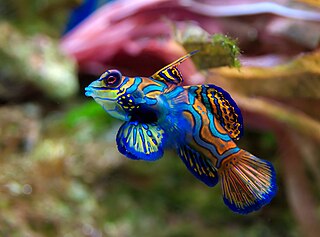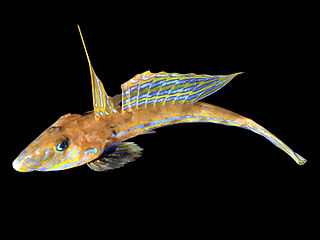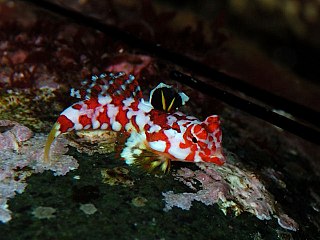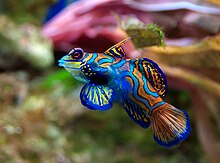
Dragonets are small, percomorph, marine fish of the diverse family Callionymidae found mainly in the tropical waters of the western Indo-Pacific. They are benthic organisms, spending most of their time near the sandy bottoms, at a depth of roughly two hundred meters. There exist 139 species of the fish, in nineteen genera.

Synchiropus splendidus, the mandarinfish or mandarin dragonet, is a small, brightly colored member of the dragonet family, which is popular in the saltwater aquarium trade. The mandarinfish is native to the Pacific, ranging approximately from the Ryukyu Islands south to Australia. It can usually be found in some of the warmer waters.
Victor Gruschka Springer was an American biologist who was a Senior Scientist emeritus, Division of Fishes at the Smithsonian Institution's National Museum of Natural History in Washington, D.C. He was a specialist in the anatomy, classification, and distribution of fishes, with a special interest in tropical marine shorefishes. He published numerous scientific studies on these subjects; also, a popular book called "Sharks in Question, the Smithsonian Answer Book" 1989.
Dr. Jack Thomson Moyer was a marine biologist and known child sexual abuser from Kansas, who lived for most of his life on Miyake-jima in Japan. Moyer was a scientist with the United States Air Force, who became a teacher later in life for the American School in Japan (ASIJ). He committed suicide in 2004. After his death, multiple allegations surfaced that Moyer had sexually molested students during his tenure at the ASIJ.

Foetorepus is a genus of dragonets. The validity of this genus has been questioned with some experts regarding it as a junior synonym of Synchiropus.

Callionymus is a genus of dragonets found mostly in the Indian and Pacific oceans with a few species occurring in the Atlantic Ocean.

Diplogrammus is a genus of dragonets.
Protogrammus is a genus of dragonets found in the Atlantic and Pacific Oceans.
Synchiropus sechellensis, the Seychelles dragonet, is a species of marine ray-finned fish, a dragonet from the family Callionymidae. It is found in the Indo-Pacific from the Red Sea south to the Seychelles and the Maldives and east as far as New Caledonia. Following a likely introduction via the Suez Canal, it was first recorded in the Mediterranean Sea in 2014; where it is found on rare occasions from Alexandria (Egypt) to the Gulf of Antalya (Turkey).

Synchiropus phaeton or the Phaeton dragonet is a species of bony fish of the family Callionymidae, the dragonets. It can be found in the Mediterranean and in the eastern Atlantic.
Synchiropus zamboangana, the Zamboangan dragonet, is a species of ray-finned fish within the family Callionymidae. The species is believed to be native to the Philippines, as only 2 specimens have been caught off Zamboanga in 1909. Due to it only having 2 specimens little is known about its population or habitat, but its assumed to live alongside continental shelves in deep waters inhabiting sandy and muddy substrate, similar to members of its genus. It has been classified as 'Data deficient' by the IUCN Red List as little is known about its ecology, population and potential threats.
Synchiropus claudiae, also known as Claudia's dragonet, is a species of fish in the dragonet family Callionymidae. It is found in the western-central Pacific Ocean.
Synchiropus grandoculis, the Western Australian bigeye dragonet, is a species of fish in the dragonet family Callionymidae. It is found in the eastern Indian Ocean along the coast of Western Australia.
Synchiropus novaecaledoniae, the West Jumeau bigeye dragonet, is a species of fish in the dragonet family Callionymidae. It is found in the western-central Pacific Ocean.
Synchiropus novaehiberniensis, the New Ireland dragonet, is a species of fish in the family Callionymidae, the dragonets. It is found in the western Pacific Ocean.
Synchiropus springeri, also known as Springer's dragonet, is a species of fish in the dragonet family Callionymidae. It is found in the western Pacific Ocean.

Synchiropus moyeri, commonly known as Moyer's dragonet, is a species of fish in the family Callionymidae, the dragonets. It is found in the western Pacific Ocean.

Synchiropus corallinus, the exclamation point dragonet, is a species of fish in the dragonet family Callionymidae. It is found in the Pacific Ocean.

Synchiropus delandi, also known as Deland's dragonet, is a species of fish in the dragonet family Callionymidae. It is found in the western-central Pacific from the Philippines to Indonesia.
Synchiropus grinnelli, the Philippines dragonet, is a species of fish in the dragonet family Callionymidae. It is found in the western-central Pacific from the Philippines to Indonesia.










